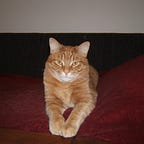How To Draw Stuff: Part 1 — Drawing a Face
Welcome to my internet short-course on drawing
You may be wondering: Sarah, how are you qualified to teach Art to anybody?
Well, the answer to that is that I took Art in Grade 12 in high school. I’m not claiming that qualifies me to know all of Art, but as I got a B+ in that course, it is numerically accurate to say that I know 87–89% of Art, which is a whole lot of Art.
So, join me on this course in which you will learn how to draw a human face.
Step 1. Draw a circle.
The trick to drawing a circle is to make it round (the rounder the better).
You may not believe this, but I did this freehand on my first attempt.
If you look closely, you may notice that my circle is not perfectly round. Most people’s circles have a rogue wobble, which can happen if the artist gets distracted by, to use a random example, a cat vomiting into her shoe. The trick in this case is to rotate the page so that the worst of the wobbles are at the bottom.
This works because when people look at art, they look at the top first and if the top looks okay, they are inclined to overlook any issues with the bottom. I think this is a lesson that someone should have taught Francisco Goya. If I had a time machine, I would go back and tell him, “Rotate ‘Saturn Devouring His Son’ 180 degrees.” Because then everyone would be admiring Saturn’s hairy goat legs and they’d fail to spot the complete absence of a vertebral column in Saturn’s son’s severed neck, which, in my opinion, completely spoils the realism of the painting.
A good rule of thumb when creating art in general is to be as anatomically accurate as possible, or, when this is not possible, to be as goat-forward as possible. And when that’s not possible, put the wobbles at the bottom.
Of course, if you’re going for peak realism, you could trace around an actual human head, but that will only work if the person you are tracing holds absolutely still, or if they are dead. If you know someone who’s about to pop off, maybe casually mention to them on their deathbed that you’d like to use their head when they’re done with it. Just try to be diplomatic. And have them sign a waiver in case someone tries to arrest you.
Step 2. Draw the hair.
This is the fun part because it’s basically squiggles. So your cat can projectile vomit into all of your footwear while you’re doing this, and it will only enhance the effect. The only caution I would give is not to go too crazy with the hair. Make sure that at least some part of the hair is in contact with some part of the head. Hair levitating a foot above the head without actually contacting the head is problematic.
I know you’ll want to be thorough, but try not to cover the entire front of the head with the hair. While this may occur in real life, when it happens in art, art critics tend to regard it as “fruity”.
Here is some hair that I did. As you can see, it’s quite good.
Step 3. Draw the ears.
These go on the sides of the head — one ear on each side.
Note that the ears that I’ve drawn are slightly different sizes. If you’ve done that and someone questions you, just tell them that you’ve embraced the natural asymmetry of Nature.
Special Note: Be careful not to put the ears too low on the head or they may be mistaken for jowls. This is a beginner’s mistake. If you did that — don’t worry. Facial hair can be used to cover most chin-adjacent errors, which is another instance of art imitating life.
Step 4. A note about the nose.
You may not know this, but noses are not necessary.
Nostrils, however, are. They allow the head to breathe.
If the nostrils commingle because someone barfed into your slipper while you were drawing them, you can just make one big nostril. It’s easier to breath through one large nostril than two small nostrils anyway.
Step 5. The eyes.
When drawn correctly, the eyes should not look like boobs. Don’t do what I did there. I was in a hurry. Cat was farting on my couch.
Step 6. The mouth.
Just draw a line. This saves time. Time to find out where the farting cat has run off to suddenly.
Congratulations! You have made a face.
Take-home Message #1: Wobbles down. Hair on. Ears up. NOSTRIL! No boobs. Line.
Take-home Message #2: Never let your cat take a bite of your extra-spicy bean burrito.
